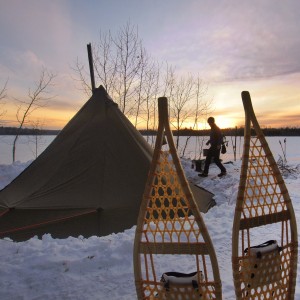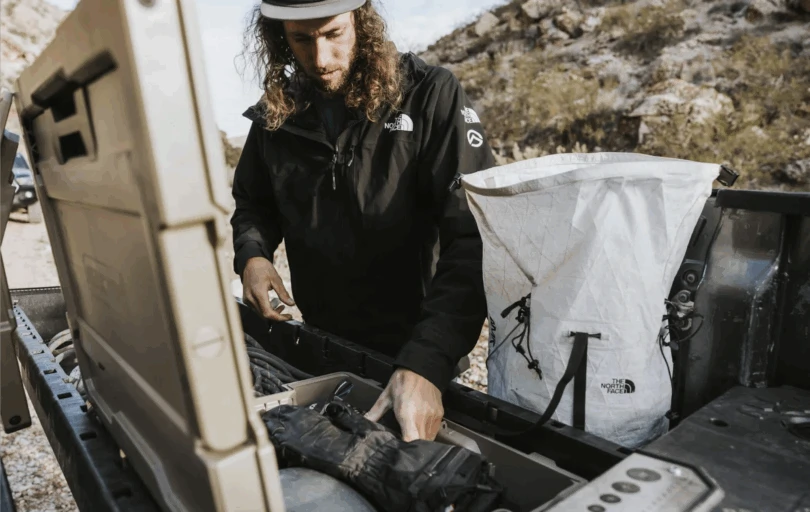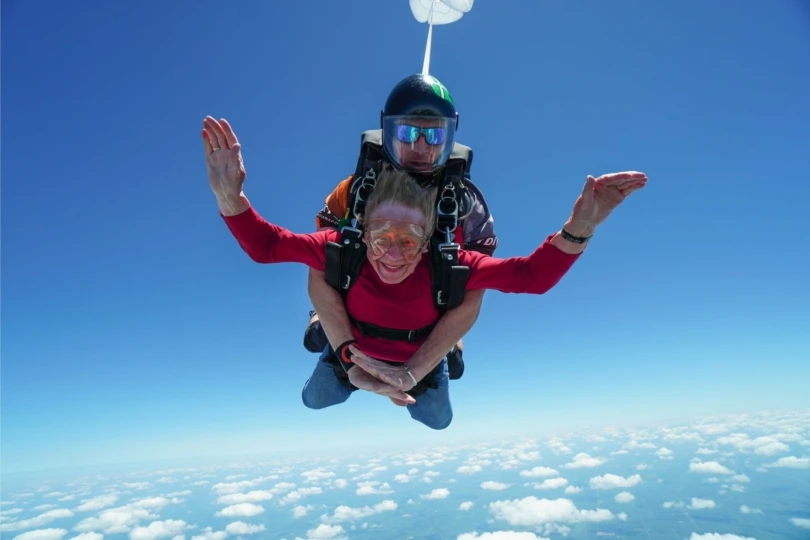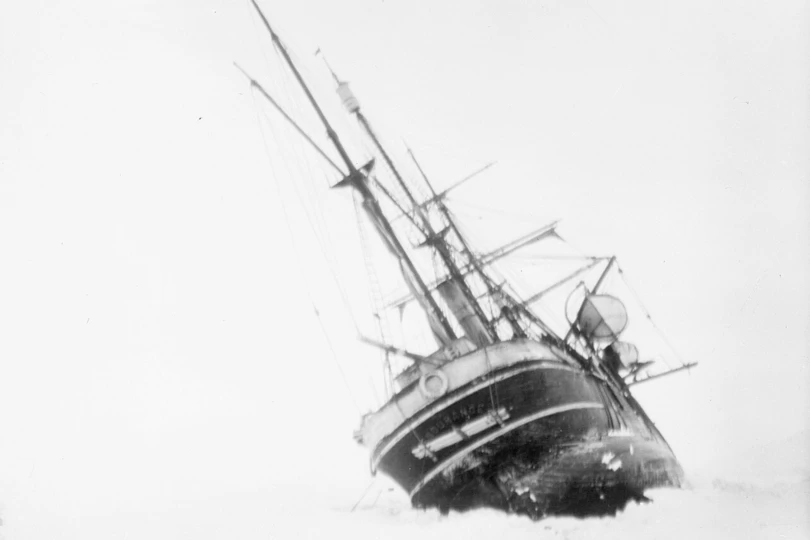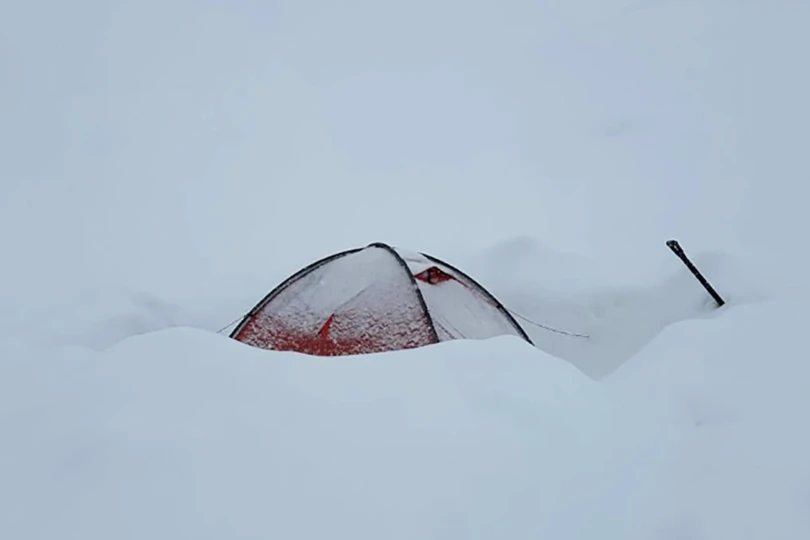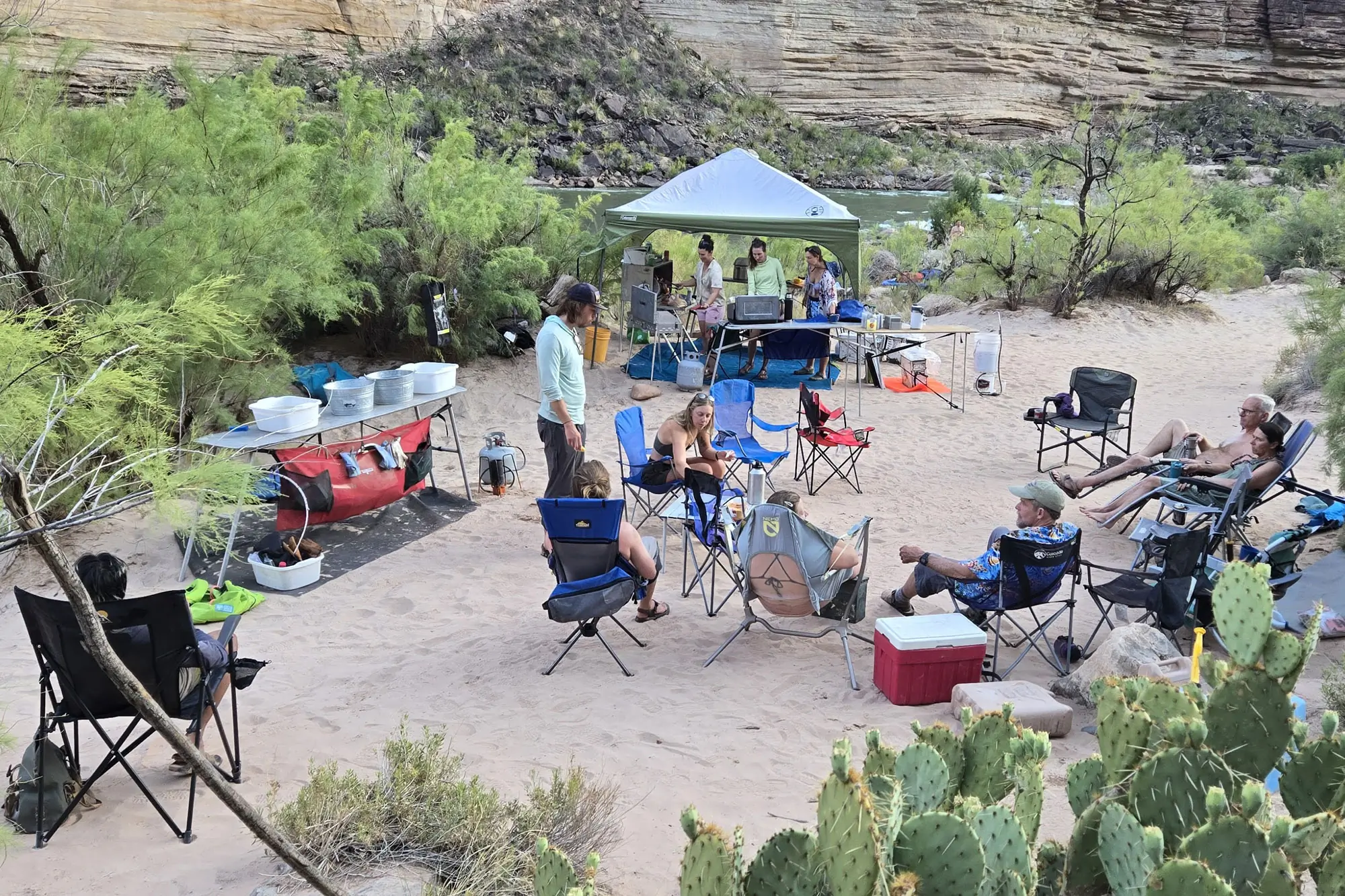[leadin]Adventurers Dave and Amy Freeman are spending a full year in the Boundary Waters of northern Minnesota, living in the Wilderness and testing gear as a part of their daily existence. They’ve spent all winter in frigid conditions, and here share 8 tips to sleep outdoors in bitterly cold weather.[/leadin]

The thermometer hovered around -20 degrees Farenheit when we cinched up our sleeping bags last week. The clear sky signaled that the mercury would continue to drop. In fact, it was 30 below when my watch alarm went off deep inside my sleeping bag.
I brushed the frost off the rim of the tiny opening around my face, quickly loaded kindling into the portable wood stove in our ultralight tipi tent, and lit the fire before zipping myself back into my warm bag to wait for the tent to warm up.
I was warm and had slept well, and Amy continued to sleep soundly in her cocoon of down and synthetic insulation next to me. It was cold, but not that cold. We have slept comfortably at -55 degrees and have helped many novice winter campers sleep comfortably at -40 degrees over the last decade. Through the years, we have discovered some tips and tricks that will help you sleep more comfortably during your next cold weather camping trip. Don’t worry – the temps don’t have to drop below zero for these hints to be useful.
Related: Warm Winter Camping Video
Choosing Your Cocoon

Choosing an appropriate sleeping bag, or combination of bags, is critical to getting a good night’s sleep at any temperature. If your bag is too warm, you will start sweating, which will cause you to get cold in the middle of the night. If your bag doesn’t have enough insulation, it will be hard to stay warm. Some people sleep warm and others sleep cold. To illustrate this point at -30 degrees I can sleep comfortably in a 15-degree inner down bag with a 40-degree synthetic outer bag. My wife uses the same 15-degree inner bag with a -10-degree outer bag. The important thing to consider is that sleeping bag temperature ratings are a guideline. What works for you may not work for your tentmate.
Amy and I really like a double bag system because it provides flexibility. If it is 0 degrees we can sleep comfortably with just one bag; if it is 40 below zero we can be fully ensconced in both bags. Two bags allow us to regulate our temperature easily.

This can also be a cheaper option because you may be able to use one or two bags that you already have. However, a two-bag system is often bulkier and heavier than a single bag. Plus, it is critical that the overbag is large enough that it doesn’t compress the inner bag. We prefer to use a down inner with a synthetic outer bag because any moisture that our body gives off overnight will pass through the down bag and freeze in the outer bag, rather than freezing in the down bag, which over time will compromise the warmth of your system.
Don’t Underestimate The Importance Of Sleeping Pads
The cold ground can suck a huge amount of heat away from your body. As the temperature drops, the insulation your sleeping pad provides is critical. In the winter, we typically use a closed cell foam pad with an insulated, inflatable pad on top. The combined R-value of our pads is 12.
Preheat Your Bag With A Hot Water Bottle
Before going to bed fill a water bottle with really hot water, make sure the lid is screwed on tight, and toss it in your sleeping bag. Then go for a brisk walk to get your blood pumping before climbing into your bag. If a body part gets cold in the middle of the night you can move your water bottle to help warm your toes, hands, thighs, etc. Plus, you will have unfrozen water to drink in the morning.
No Diets Allowed!
Your body is going to burn more calories sleeping out in the cold. Warming all the cold air you breathe in and out takes extra energy. If your body runs out of fuel at 3am you are more likely to get cold. Fats burn slowly, so adding cheese, butter, and other fatty foods to your diet is important. Bring an energy bar, or another easy to eat calorie-dense snack to bed. A midnight snack will help you stay warm.
What Should I Wear?
Many debates have been had around the campfire about what to wear on a cold night. Everyone is different, but these 4 factors are universal.

1. All your clothing should be bone dry when you hit the sack. Keeping a second set of long underwear to sleep in and a thick pair of clean, dry socks is very helpful. The long underwear and socks that you wore all day likely contain moisture, even if they feel dry.
2. Your clothing should be breathable. I often wear fleece pants and fleece jacket over my base layer, but avoid outer layers that will trap moisture because they can cause you to wake up cold and clammy in the middle of the night.
3. Wear an even amount of clothing. If you wear a thin pair of socks, a thick fleece jacket and long underwear to bed, you will likely wake up with a warm core and cold feet. Try to layer evenly and if you have trouble keeping your toes warm, consider wearing your camp booties to bed, or wrapping your feet in an extra fleece, down jacket, etc.
4. Cover your head and neck, and block drafts, but don’t burrow your head into your sleeping bag. I have a friend who sleeps with three hats and a neck gator. Keep that noggin warm, but don’t breathe into your sleeping bag or you will wake up warm and wet. Over time, all the added moisture will make your bag cold and clammy. If your sleeping bag doesn’t have a good draft collar, use a fleece layer to form a barrier around your shoulders and neck to fend off drafts.
Keep Your Toes Toasty
Cold feet are a common reason people don’t sleep well in the cold. Dry socks, camp booties, a hot water bottle down by your feet, and filling extra space at the bottom of your sleeping bag with extra clothing if it is too long can all help. If you wake up with cold feet, or you are cold in general try taking your socks off and then putting them back on without getting out of your sleeping bag. It might sound easy, but it is not. Otherwise, crunches or other exercises while bundled in your bag are great ways to warm up.
Join The 9 O’clock Club
On a cold, dark night after a long day, it can be tempting to crawl into your bag as soon as the sun sets. However, at 4 AM you will likely be wide awake, hungry, and wondering how much longer it will be before sunrise. Enjoy the stars and campfire, or a card game with your tentmates to stay awake until 9pm.

What If I Have To Pee?
Keep snacking until you go to bed, but try to be fully hydrated an hour or two before bedtime to limit the need to climb out of your cocoon in the wee hours of the night. If you have to pee, do yourself a favor – get up and go. Otherwise, you will just toss and turn for two hours and then get up and go anyway. I sleep with my headlamp on my head, or around my neck so it is easy to grab. Keep your mittens, boots, and other necessities at hand. A pee bottle can also be a good option. Some people use a pee bottle while inside their bag (slightly dangerous). We prefer to get out of our bags to use the pee bottle. Any wide mouth container with a good lid that you won’t confuse with your water bottle will do.
Practice Makes Perfect
Cold is relative and has more to do with what you are used to and what you are prepared for than the actual temperature. If it’s 30 or -30 degrees the next time you are preparing to sleep out in the cold, I hope these tips and tricks will help you stay warm. If you wake up too cold or too hot, try to remember it happens to all of us. Even after hundreds of nights sleeping out in the cold, I still don’t always get a good night’s sleep. Sometimes you layer wrong, drink too much, don’t eat enough, or flub the ever-changing recipe. Remember, it gets easier with practice, learn from your mistakes, and don’t let a cold night or two deter you. Amy and I camped in the Wilderness all winter and we can count on one hand how many times we have woken up cold. It just takes practice.
We have led hundreds of first-time winter campers on dogsled camping trips through Wintergreen Dogsled Lodge. It is not uncommon for first-time winter campers to not sleep well for the first night or two, but by the third night, they have started to dial in a system that works for them and are able to sleep comfortably.
– Dave Freeman and his wife Amy are spending a year in the Boundary Waters Canoe Area Wilderness in an effort to protect the Boundary Waters from a series of sulfide-ore copper mines that are proposed along the edge of our nation’s most popular Wilderness. Throughout their “Year in the Wilderness” they are sharing regular reviews on GearJunkie.com. Dave and Amy were named National Geographic Adventurers of the Year in 2014.

